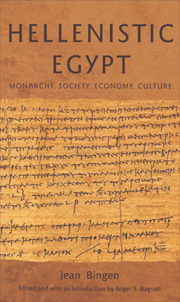Book contents
- Frontmatter
- Contents
- Original Sources of Chapters
- List of illustrations
- Glossary
- Maps
- Foreword
- Introduction: Jean Bingen and the currents of Ptolemaic history
- Part I The Monarchy
- Part II The Greeks
- Part III The Royal Economy
- 13 The Revenue Laws Papyrus: Greek tradition and Hellenistic adaptation
- 14 The structural tensions of Ptolemaic society
- 15 The third-century land-leases from Tholthis
- Part IV Greeks and Egyptians
- Conclusion
- Bibliography
- General index
- Index of passages discussed
- HELLENISTIC CULTURE AND SOCIETY
14 - The structural tensions of Ptolemaic society
from Part III - The Royal Economy
- Frontmatter
- Contents
- Original Sources of Chapters
- List of illustrations
- Glossary
- Maps
- Foreword
- Introduction: Jean Bingen and the currents of Ptolemaic history
- Part I The Monarchy
- Part II The Greeks
- Part III The Royal Economy
- 13 The Revenue Laws Papyrus: Greek tradition and Hellenistic adaptation
- 14 The structural tensions of Ptolemaic society
- 15 The third-century land-leases from Tholthis
- Part IV Greeks and Egyptians
- Conclusion
- Bibliography
- General index
- Index of passages discussed
- HELLENISTIC CULTURE AND SOCIETY
Summary
However privileged papyrology may be among the documentary sources for the Hellenistic period – only a few great epigraphical sites can offer anything comparable – it remains true that this documentation presents discontinuities of various sorts. These are the more embarrassing in that we have too few historical sources to be able to draw from them a synthesis of the evolution of Ptolemaic Egypt or a balanced image of it. The discontinuities are first geographic: we jump from one site to another, and these sites are most often isolated points, whose typicality for their period is hard to discern. To these geographic discontinuities are added chronological ones. Even when a site is, exceptionally, known from several points in the Hellenistic period, it is difficult to bridge them, as we find with Tebtynis between the papyri of the third and second centuries, or at Herakleopolis, between the cleruchic documents of the third century and those of the first. To these discontinuities we could add the cultural gap between Greek and Demotic documentation, a discontinuity aggravated and misplaced as a result of scholarly specialisation.
- Type
- Chapter
- Information
- Hellenistic EgyptMonarchy, Society, Economy, Culture, pp. 189 - 205Publisher: Edinburgh University PressPrint publication year: 2007

